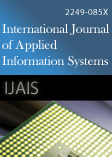
- Sumit Kumar Banchhor and Arif Khan 2012. Musical Instrument Recognition using Zero Crossing Rate and Short-time Energy. International Journal of Applied Information Systems. 1, 3 (February 2012), 16-19. DOI=http://dx.doi.org/10.5120/ijais450131
-
@article{10.5120/ijais2017451568, author = {Sumit Kumar Banchhor and Arif Khan}, title = {Musical Instrument Recognition using Zero Crossing Rate and Short-time Energy}, journal = {International Journal of Applied Information Systems}, issue_date = {February 2012}, volume = {1}, number = {}, month = {February}, year = {2012}, issn = {}, pages = {16-19}, numpages = {}, url = {/archives/volume1/number3/73-0131}, doi = { 10.5120/ijais12-450131}, publisher = { xA9 2010 by IJAIS Journal}, address = {} } -
%1 450131 %A Sumit Kumar Banchhor %A Arif Khan %T Musical Instrument Recognition using Zero Crossing Rate and Short-time Energy %J International Journal of Applied Information Systems %@ %V 1 %N %P 16-19 %D 2012 %I xA9 2010 by IJAIS Journal
Abstract
Many real time network applications like teleconferences, online gaming, video-on-demand, Pay-per-view video streaming are based on group communications. These applications can be implemented by using secure multicast in which Group communication is secured by encrypting / decrypting data stream with a cryptographic key. Due to dynamic nature of group, the group key is needed to be changed dynamically to maintain backward secrecy and forward secrecy. In case of frequent join/leave operations, re-keying process becomes major issue. In this paper, a novel scheme for multicast group key establishment has been developed by using one-way function tree of degree three. The ternary OFT key tree is a particular type of ternary tree in which each interior node has maximum three children. Every leaf of the tree is associated with a group member, and the node secret of the root is the common group key. Group members can use this group key to communicate among themselves. This Scheme reduces overall runtime required for join/leave operations, lessens number of keys stored by group members, and requires minimum number of key-broadcasts to the group when new members are added or evicted. It also reduces computational cost of group manager in large dynamic multicast group.
References
- K.D. Martin: Sound-Source Recognition: A Theory and Computational Model, Ph.D. thesis, MIT, 1999
- A. Livshin, X. Rodet: Musical Instrument Identification in Continuous Recordings, Proc. of the 7th Int. Conference on Digital Audio Effects (DAFX-04), Naples, Italy, October 5-8, 2004
- A. Eronen, A. Klapuri: Musical Instrument Recognition Using Cepstral Coefficients and Temporal Features, Proc. of the IEEE International Conference on Acoustics, Speech and Signal Processing, ICASSP 2000, pp. 753-756
- T. Kitahara, M. Goto, H. Okuno: Musical Instrument Identification Based on F0-Dependent Multivariate Normal Distribution, Proc. of the 2003 IEEE Int'l Conf. on Acoustic, Speech and Signal Processing (ICASSP '03), Vol.V, pp.421-424, Apr. 2003
- A. Eronen: Musical instrument recognition using ICA-based transform of features and discriminatively trained HMMs, Proc. of the Seventh International Symposium on Signal Processing and its Applications, ISSPA 2003, Paris, France, 1-4 July 2003, pp. 133-136
- G. De Poli, P. Prandoni: Sonological Models for Timbre Characterization, Journal of New Music Research, Vol 26 (1997), pp. 170-197, 1997
Keywords
Musical Instrument classification, generalization, zero crossing rate, short time energy
 10.5120/ijais12-450131
10.5120/ijais12-450131
